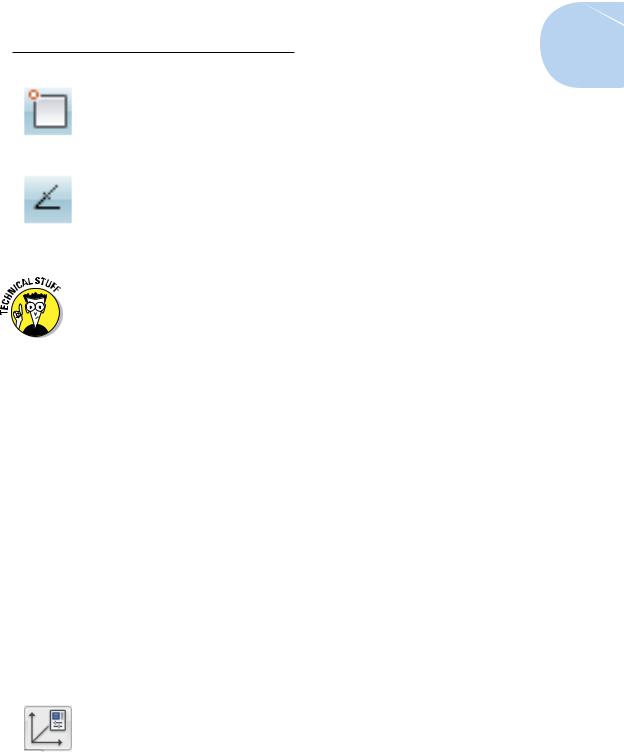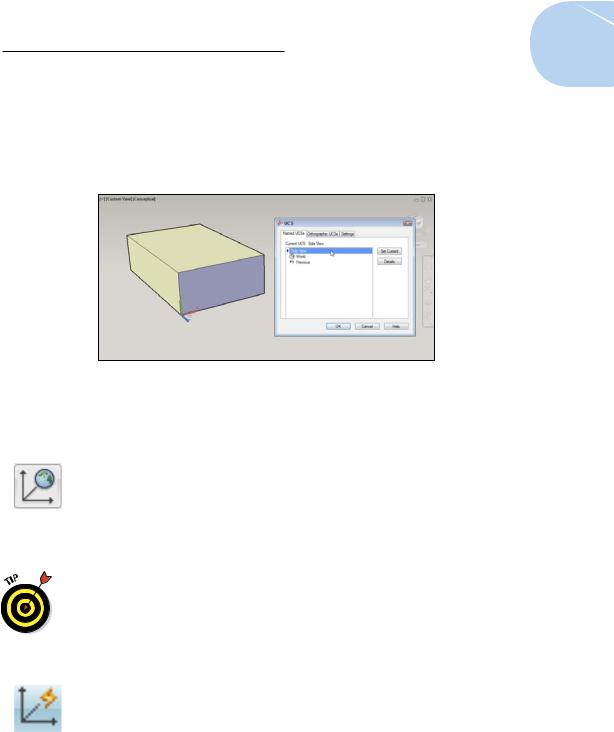
- •About the Authors
- •Dedication
- •Authors’ Acknowledgments
- •Table of Contents
- •Introduction
- •What’s Not (And What Is) in This Book
- •Mac attack!
- •Who Do We Think You Are?
- •How This Book Is Organized
- •Part I: AutoCAD 101
- •Part II: Let There Be Lines
- •Part III: If Drawings Could Talk
- •Part IV: Advancing with AutoCAD
- •Part V: On a 3D Spree
- •Part VI: The Part of Tens
- •But wait . . . there’s more!
- •Icons Used in This Book
- •A Few Conventions — Just in Case
- •Commanding from the keyboard
- •Tying things up with the Ribbon
- •Where to Go from Here
- •Why AutoCAD?
- •The Importance of Being DWG
- •Seeing the LT
- •Checking System Requirements
- •Suddenly, It’s 2013!
- •AutoCAD Does Windows (And Office)
- •And They’re Off: AutoCAD’s Opening Screens
- •Running with Ribbons
- •Getting with the Program
- •Looking for Mr. Status Bar
- •Let your fingers do the talking: The command window
- •The key(board) to AutoCAD success
- •Keeping tabs on palettes
- •Down the main stretch: The drawing area
- •Fun with F1
- •A Simple Setup
- •Drawing a (Base) Plate
- •Drawing rectangles on the right layers
- •Circling your plate
- •Nuts to you
- •Getting a Closer Look with Zoom and Pan
- •Modifying to Make It Merrier
- •Hip-hip-array!
- •Stretching out
- •Crossing your hatches
- •Following the Plot
- •A Setup Roadmap
- •Choosing your units
- •Weighing up your scales
- •Thinking annotatively
- •Thinking about paper
- •Defending your border
- •A Template for Success
- •Making the Most of Model Space
- •Setting your units
- •Making the drawing area snap-py (and grid-dy)
- •Setting linetype and dimension scales
- •Entering drawing properties
- •Making Templates Your Own
- •Setting Up a Layout in Paper Space
- •Will that be tabs or buttons?
- •View layouts Quick(View)ly
- •Creating a layout
- •Copying and changing layouts
- •Lost in paper space
- •Spaced out
- •A view(port) for drawing in
- •About Paper Space Layouts and Plotting
- •Managing Your Properties
- •Layer one on me!
- •Accumulating properties
- •Creating new layers
- •Manipulating layers
- •Using Named Objects
- •Using AutoCAD DesignCenter
- •Copying layers between drawings
- •Controlling Your Precision
- •Keyboard capers: Coordinate input
- •Understanding AutoCAD’s coordinate systems
- •Grab an object and make it snappy
- •Other Practical Precision Procedures
- •Introducing the AutoCAD Drawing Commands
- •The Straight and Narrow: Lines, Polylines, and Polygons
- •Toeing the line
- •Connecting the lines with polyline
- •Squaring off with rectangles
- •Choosing your sides with polygon
- •(Throwing) Curves
- •Going full circle
- •Arc-y-ology
- •Solar ellipses
- •Splines: The sketchy, sinuous curves
- •Donuts: The circles with a difference
- •Revision clouds on the horizon
- •Scoring Points
- •Commanding and Selecting
- •Command-first editing
- •Selection-first editing
- •Direct object manipulation
- •Choosing an editing style
- •Grab It
- •One-by-one selection
- •Selection boxes left and right
- •Perfecting Selecting
- •AutoCAD Groupies
- •Object Selection: Now You See It . . .
- •Get a Grip
- •About grips
- •A gripping example
- •Move it!
- •Copy, or a kinder, gentler Move
- •A warm-up stretch
- •Your AutoCAD Toolkit
- •The Big Three: Move, Copy, and Stretch
- •Base points and displacements
- •Move
- •Copy
- •Copy between drawings
- •Stretch
- •More Manipulations
- •Mirror
- •Rotate
- •Scale
- •Array
- •Offset
- •Slicing, Dicing, and Splicing
- •Trim and Extend
- •Break
- •Fillet and Chamfer and Blend
- •Join
- •When Editing Goes Bad
- •Zoom and Pan with Glass and Hand
- •The wheel deal
- •Navigating your drawing
- •Controlling your cube
- •Time to zoom
- •A View by Any Other Name . . .
- •Looking Around in Layout Land
- •Degenerating and Regenerating
- •Getting Ready to Write
- •Simply stylish text
- •Taking your text to new heights
- •One line or two?
- •Your text will be justified
- •Using the Same Old Line
- •Turning On Your Annotative Objects
- •Saying More in Multiline Text
- •Making it with Mtext
- •It slices; it dices . . .
- •Doing a number on your Mtext lists
- •Line up in columns — now!
- •Modifying Mtext
- •Gather Round the Tables
- •Tables have style, too
- •Creating and editing tables
- •Take Me to Your Leader
- •Electing a leader
- •Multi options for multileaders
- •How Do You Measure Up?
- •A Field Guide to Dimensions
- •The lazy drafter jumps over to the quick dimension commands
- •Dimension associativity
- •Where, oh where, do my dimensions go?
- •The Latest Styles in Dimensioning
- •Creating and managing dimension styles
- •Let’s get stylish!
- •Adjusting style settings
- •Size Matters
- •Details at other scales
- •Editing Dimensions
- •Editing dimension geometry
- •Editing dimension text
- •Controlling and editing dimension associativity
- •Batten Down the Hatches!
- •Don’t Count Your Hatches. . .
- •Size Matters!
- •We can do this the hard way. . .
- •. . . or we can do this the easy way
- •Annotative versus non-annotative
- •Pushing the Boundary (Of) Hatch
- •Your hatching has no style!
- •Hatch from scratch
- •Editing Hatch Objects
- •You Say Printing, We Say Plotting
- •The Plot Quickens
- •Plotting success in 16 steps
- •Get with the system
- •Configure it out
- •Preview one, two
- •Instead of fit, scale it
- •Plotting the Layout of the Land
- •Plotting Lineweights and Colors
- •Plotting with style
- •Plotting through thick and thin
- •Plotting in color
- •It’s a (Page) Setup!
- •Continuing the Plot Dialog
- •The Plot Sickens
- •Rocking with Blocks
- •Creating Block Definitions
- •Inserting Blocks
- •Attributes: Fill-in-the-Blank Blocks
- •Creating attribute definitions
- •Defining blocks that contain attribute definitions
- •Inserting blocks that contain attribute definitions
- •Edit attribute values
- •Extracting data
- •Exploding Blocks
- •Purging Unused Block Definitions
- •Arraying Associatively
- •Comparing the old and new ARRAY commands
- •Hip, hip, array!
- •Associatively editing
- •Going External
- •Becoming attached to your xrefs
- •Layer-palooza
- •Creating and editing an external reference file
- •Forging an xref path
- •Managing xrefs
- •Blocks, Xrefs, and Drawing Organization
- •Mastering the Raster
- •Attaching a raster image
- •Maintaining your image
- •Theme and Variations: Dynamic Blocks
- •Lights! Parameters!! Actions!!!
- •Manipulating dynamic blocks
- •Maintaining Design Intent
- •Defining terms
- •Forget about drawing with precision!
- •Constrain yourself
- •Understanding Geometric Constraints
- •Applying a little more constraint
- •AutoConstrain yourself!
- •Understanding Dimensional Constraints
- •Practice a little constraint
- •Making your drawing even smarter
- •Using the Parameters Manager
- •Dimensions or constraints — have it both ways!
- •The Internet and AutoCAD: An Overview
- •You send me
- •Send it with eTransmit
- •Rapid eTransmit
- •Bad reception?
- •Help from the Reference Manager
- •Design Web Format — Not Just for the Web
- •All about DWF and DWFx
- •Autodesk Design Review 2013
- •The Drawing Protection Racket
- •Autodesk Weather Forecast: Increasing Cloud
- •Working Solidly in the Cloud
- •Free AutoCAD!
- •Going once, going twice, going 123D
- •Your head planted firmly in the cloud
- •The pros
- •The cons
- •Cloudy with a shower of DWGs
- •AutoCAD 2013 cloud connectivity
- •Tomorrow’s Forecast
- •Understanding 3D Digital Models
- •Tools of the Trade
- •Warp speed ahead
- •Entering the third dimension
- •Untying the Ribbon and opening some palettes
- •Modeling from Above
- •Using 3D coordinate input
- •Using point filters
- •Object snaps and object snap tracking
- •Changing Planes
- •Displaying the UCS icon
- •Adjusting the UCS
- •Navigating the 3D Waters
- •Orbit à go-go
- •Taking a spin around the cube
- •Grabbing the SteeringWheels
- •Visualizing 3D Objects
- •Getting Your 3D Bearings
- •Creating a better 3D template
- •Seeing the world from new viewpoints
- •From Drawing to Modeling in 3D
- •Drawing basic 3D objects
- •Gaining a solid foundation
- •Drawing solid primitives
- •Adding the Third Dimension to 2D Objects
- •Creating 3D objects from 2D drawings
- •Modifying 3D Objects
- •Selecting subobjects
- •Working with gizmos
- •More 3D variants of 2D commands
- •Editing solids
- •Get the 2D Out of Here!
- •A different point of view
- •But wait! There’s more!
- •But wait! There’s less!
- •Do You See What I See?
- •Visualizing the Digital World
- •Adding Lighting
- •Default lighting
- •User-defined lights
- •Sunlight
- •Creating and Applying Materials
- •Defining a Background
- •Rendering a 3D Model
- •Autodesk Feedback Community
- •Autodesk Discussion Groups
- •Autodesk’s Own Bloggers
- •Autodesk University
- •The Autodesk Channel on YouTube
- •The World Wide (CAD) Web
- •Your Local ATC
- •Your Local User Group
- •AUGI
- •Books
- •Price
- •3D Abilities
- •Customization Options
- •Network Licensing
- •Express Tools
- •Parametrics
- •Standards Checking
- •Data Extraction
- •MLINE versus DLINE
- •Profiles
- •Reference Manager
- •And The Good News Is . . .
- •APERTURE
- •DIMASSOC
- •MENUBAR
- •MIRRTEXT
- •OSNAPZ
- •PICKBOX
- •REMEMBERFOLDERS
- •ROLLOVERTIPS
- •TOOLTIPS
- •VISRETAIN
- •And the Bonus Round
- •Index

Chapter 21: It’s a 3D World After All 479
3D object snaps allow you to specify points on 3D objects that regular object snaps won’t recognize — for example, the center of a face, or a vertex. You enable 3D object snaps by clicking the 3D Object Snap button on the status bar. Right-click the 3D Object Snap button and choose the running 3D object snap modes you want to use.
Object snap tracking allows you to calculate points that are not on an object by using object snap points on existing objects. When working in 3D, you can not only track points on the current X, Y plane but also along the Z axis.
While tracking points along the Z axis, AutoCAD provides feedback in the form of a tooltip that lets you know you’re moving along the Z axis in the positive or negative direction.
The ELEVATION system variable allows you to specify a height above or below the current working plane. When you enter a 2D coordinate, AutoCAD uses the value assigned to ELEVATION system variable (by default, it’s 0) to create a 3D coordinate. You can set the OSNAPZ system variable to 1, to
substitute the Z coordinate value of a point specified by using an object snap with the value of ELEVATION.
Changing Planes
Come fly with us while we explain changing planes in AutoCAD. (Just step through this metal detector over here while we X-ray your bags.)
Okay, it’s not that kind of plane. This section covers using the user coordinate system (UCS) to control the current working (or X, Y) plane. The UCS icon displayed either at the lower-left corner of the drawing window or at the origin (0, 0, 0) shows you the orientation of the current work plane and the positive direction of the Z axis.
Displaying the UCS icon
By default, the UCS icon is displayed in both 2D and 3D views. You can lose your bearings pretty easily when working in 3D, and we strongly recommend that you keep the UCS icon in your sights at all times. If you don’t see a UCS icon, you can turn it on from the Coordinates panel of the View tab on the Ribbon. Click the button with the burned-out light bulb and choose either Show UCS Icon or Show UCS Icon at Origin.
In addition to controlling the display of the UCS icon, you can also tweak its size, color, and location by using the UCS Icon dialog box. To display the UCS Icon dialog box, choose UCS Icon, Properties on the Coordinates panel of the Home tab.
www.it-ebooks.info

480 Part V: On a 3D Spree
In previous releases, the UCS icon was merely a graphic indicator of the current coordinate system. If you set a new user coordinate system in model space, the UCS icon adjusted itself to show you the orientation of the new X, Y plane and Z axis. In other words, the UCS icon was driven by the current coordinate system. Beginning with AutoCAD 2012, the UCS icon moves across to the driver’s seat! You can now select the UCS icon and see new multifunction grips that allow you to set a new UCS by dragging the grips on the origin and the legs of the icon. There’s also a new right-click menu. You can enable or disable UCS icon selectability on the Settings tab of the UCS dialog box — type UCSMAN to open it. In the next section, we show you how to create a new user coordinate system by selecting and manipulating the UCS icon.
Adjusting the UCS
Every drawing you create uses the World Coordinate System (WCS), but when working in 3D, you need to create additional work planes. User coordinate systems (UCSs) are necessary when you need to draw objects on work planes other than the WCS. In the real world, think of latitude and longitude as the WCS; street naming, house numbering, and hotel room numbers are all local systems and are equivalent to UCSs. Traditional UCSs are static; create one, and it stays current until you change it. By default, such coordinate systems are unnamed, but you can assign a name and save it for future use. A couple of releases back, AutoCAD introduced dynamic UCSs. Because dynamic is the opposite of static, what you get is a temporary coordinate system that changes as you move your mouse pointer over different planar faces of a 3D object. Use the status bar Allow/Disallow Dynamic UCS button on the status bar, or press the F6 key to toggle dynamic UCS on and off.
Name that UCS
The UCS command offers ten options to help you define a new UCS. Access the UCS command options from the Coordinates panels on either the View or Home tab of the Ribbon.
The most commonly used options of the UCS command are listed below. After you select one of these options from the Ribbon, follow the command prompts at the command line or the Dynamic Input prompt.
World: Align the UCS to match the WCS.
Face: Align the UCS to the face of a 3D solid.
View: Align the UCS so that the X plane is perpendicular to your current viewing direction.
3 Point: Specify a new origin for the UCS, and then the positive direction of the X and Y axes. Alternatively, use the multifunction grips on AutoCAD’s UCS icon to create a new UCS by moving and realigning the icon.
www.it-ebooks.info

Chapter 21: It’s a 3D World After All 481
For more information on all the UCS command’s options, refer to AutoCAD’s online help system.
The more UCSs in your drawing, the more you need help managing them. AutoCAD offers a handy dandy UCS dialog box for doing just that. Open it by clicking the dialog box launcher (the little arrow at the right end of the panel label) on the Coordinates panel of the View or Home tab, or simply type UCSMAN and press Enter. The three tabs in the UCS dialog box are
Named UCSs: Lists World and other user coordinate systems. Set a UCS current with the Set Current button, or right-click a UCS to rename or delete a named UCS. (You can’t rename or delete the World UCS.)
Orthographic UCSs: Lists the six default orthographic coordinate systems (front and back, left and right, top and bottom) relative to the WCS. These UCSs are automatically created by AutoCAD and can’t be deleted or renamed.
Settings: Controls properties of both the UCS icon and the UCS itself.
After you define a UCS that you think you might want to use again, you can save it in the UCS dialog box. We explain how in the following steps, which you begin by creating a solid box.
1.Start a new 3D drawing by selecting acad3d.dwt (or acadiso3d. dwt for the metric crowd) for your template, and ensure that the 3D Modeling workspace is current.
Refer to the steps in the “Entering the third dimension” section, earlier in the chapter, if you need a refresher.
2.On the Modeling panel of the Home tab, click Box.
AutoCAD prompts:
Specify first corner or [Center]:
3. Type 0,0,0 and then press Enter.
AutoCAD anchors the first corner of the box at the origin of the WCS and prompts:
Specify other corner or [Cube/Length]:
4.Drag your crosshairs away from the first corner and click a point to set the length and width of the box.
Exact distances don’t matter in this example. AutoCAD prompts:
Specify height or [2Point]:
www.it-ebooks.info

482 Part V: On a 3D Spree
5.Drag the crosshairs upward from the second corner and click to set the height of the box.
AutoCAD creates the 3D box and exits the command. Preliminaries are over. Now it’s time to start making some UCSs.
6.Move the crosshairs over the UCS icon.
The UCS icon shows the orientation of the World Coordinate System. As you move the crosshairs over the icon, it turns a greenish-gold color, indicating that it can be selected.
7.Click to select the UCS icon.
A square multifunction grip appears at the origin, and round multifunction grips appear at the ends of the icon’s legs.
8.Move the crosshairs over each multifunction grip and look at the grip menus.
Hovering over one of the round grips at the end of a leg lets you choose between realigning the selected axis, or rotating the UCS around one of the unselected axes. Hovering the mouse pointer over the origin grip lets you move the UCS origin to a new location and either keep the current alignment of the X and Y axes or realign them. The third grip option, World, restores the WCS.
Now you use the UCS icon’s multifunction grips to set a new UCS.
9.Click the UCS icon to select it, and then move the crosshairs over the square multifunction grip at the origin.
The crosshairs jump to the origin and the grip menu appears.
10.From the grip menu, choose Move and Align.
AutoCAD prompts:
** MOVE AND ALIGN **
Specify origin point or align to face, surface, or mesh:
Move the crosshairs to a different corner of the box, and when the UCS icon origin is over the corner, click to set the new origin.
If you want, you can drag the round grips on the axes to realign the new UCS. After you have it the way you want, it’s worth saving it. The next steps show how.
11.On the Coordinates panel of the Home tab, choose UCS, Named UCS.
AutoCAD displays the UCS dialog box.
12.With the Named UCSs tab current, select Unnamed in the UCSs list.
The new, unnamed UCS is the current UCS in the drawing and is listed at the top of the list.
www.it-ebooks.info

Chapter 21: It’s a 3D World After All 483
13.Right-click Unnamed and choose Rename from the shortcut menu.
An in-place editor is displayed that allows you to rename the UCS.
14.Type a name for the new UCS press Enter.
The Unnamed UCS is renamed (see Figure 21-3).
Figure 21-3: Naming a custom UCS.
15.Click OK.
The UCS dialog box closes, and the new UCS is saved in the drawing.
16.On the Coordinates panel of the Home tab, choose UCS, World.
The current UCS is now aligned with the WCS.
17.On the Coordinates panel of the Home tab, click in the Named UCS drop-down list and choose the name of the UCS you just saved.
The new UCS is restored.
AutoCAD likes giving you lots of choices. You can also restore a named UCS from the UCS drop-down list at the bottom of the ViewCube. (We fill you in on the ViewCube in the “Taking a spin around the cube” section, later in this chapter.) Or you can right-click the UCS icon, choose Named UCS, and then choose the UCS from the menu.
Using Dynamic UCS
A named UCS allows you to work on different work planes, but it can take a bit of effort to set up and that can distract you when you’re focused on 3D modeling. With Dynamic UCS, you can focus on modeling, not on creating a UCS. To enable or disable the dynamic UCS feature, click the Dynamic UCS button on the status bar.
Figure 21-4 shows an example of drawing a circle on the side of a 3D solid. With Dynamic UCS enabled, AutoCAD highlights the face of the 3D solid that
www.it-ebooks.info
